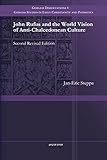John Rufus and the World Vision of Anti-Chalcedonean Culture : Second Revised Edition / Jan-Eric Steppa.
Material type: TextSeries: Gorgias Studies in Early Christianity and PatristicsPublisher: Piscataway, NJ : Gorgias Press, [2014]Copyright date: ©2014Description: 1 online resource (232 p.)Content type:
TextSeries: Gorgias Studies in Early Christianity and PatristicsPublisher: Piscataway, NJ : Gorgias Press, [2014]Copyright date: ©2014Description: 1 online resource (232 p.)Content type: - 9781463203894
- 9781463236342
- 273/.5 23
- BR225 .S74 2014
- online - DeGruyter
| Item type | Current library | Call number | URL | Status | Notes | Barcode | |
|---|---|---|---|---|---|---|---|
 eBook
eBook
|
Biblioteca "Angelicum" Pont. Univ. S.Tommaso d'Aquino Nuvola online | online - DeGruyter (Browse shelf(Opens below)) | Online access | Not for loan (Accesso limitato) | Accesso per gli utenti autorizzati / Access for authorized users | (dgr)9781463236342 |
Browsing Biblioteca "Angelicum" Pont. Univ. S.Tommaso d'Aquino shelves, Shelving location: Nuvola online Close shelf browser (Hides shelf browser)

|

|

|

|

|

|

|
||
| online - DeGruyter Aphrahat the Persian Sage and the Temple of God : A Study of Early Syriac Theological Anthropology / | online - DeGruyter St. Cyril of Alexandria, A New Testament Exegete : His Commentary on the Gospel of John / | online - DeGruyter Simple and Bold : Ephrem’s Art of Symbolic Thought / | online - DeGruyter John Rufus and the World Vision of Anti-Chalcedonean Culture : Second Revised Edition / | online - DeGruyter Healing in the Theology of Saint Ephrem / | online - DeGruyter Negotiating Island Identities : The Active Use of Pottery in the Middle and Late Bronze Age Cyclades / | online - DeGruyter "Epistolarity" in the First Book of Horace's Epistles / |
Frontmatter -- Preface and Acknowledgments -- Contents -- Abbreviations -- Introduction -- 1. The Stage of the Resistance -- 2. The Texts -- 3. The Images of Authority -- 4. Signs and Revelations -- 5. The Image of the Enemies -- Conclusion -- Bibliography -- Index
restricted access online access with authorization star
http://purl.org/coar/access_right/c_16ec
This book deals with the works of the anti-Chalcedonian hagiographer, John Rufus, and traces the basic motives behind the opposition against the council of Chalcedon in the fifth century through an attempt to reconstruct a specific anti-Chalcedonian culture. As part of the eastern monastic culture, it considered itself a counter-culture guarding purity of ascetic conduct and orthodoxy from being defiled by the perverseness of the majority. Reading John Rufus' hagiography, we find ourselves in the midst of a cosmological warfare between good and evil, where the great heroes of the anti-Chalcedonian movement enter into history as God's warriors against the rebellion of demons and heretics.
Mode of access: Internet via World Wide Web.
In English.
Description based on online resource; title from PDF title page (publisher's Web site, viewed 08. Aug 2023)


